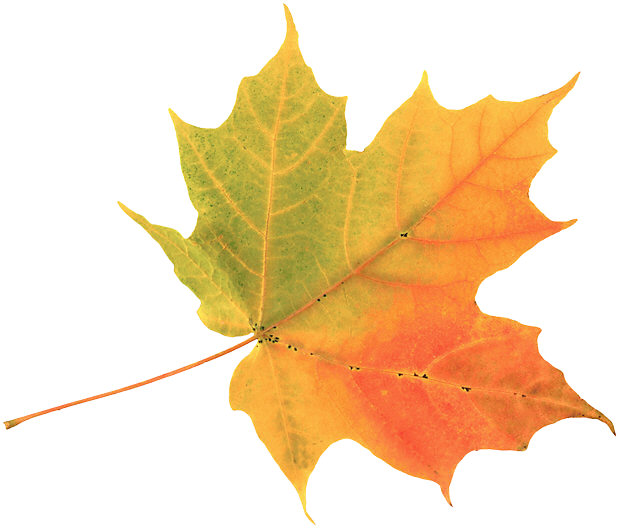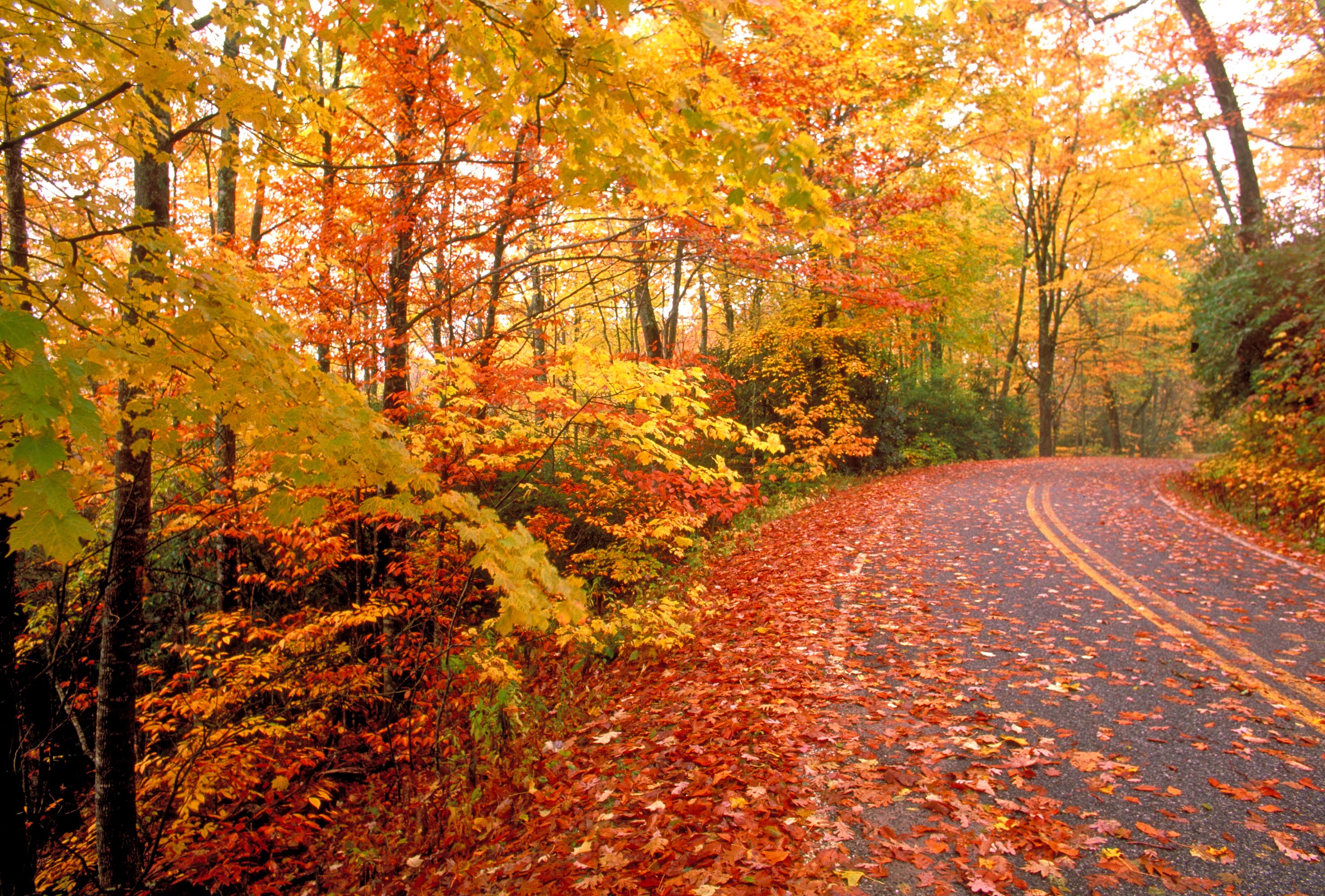I have had a request! Daily Apple reader Marietta wants to know:

Maple leaf changing color. Once you read this entry, you will know to say, "You can see where the chlorophyll has faded and the carotenoid pigment has become apparent."
(Image from Outdoor Parent)
Have you done a Daily Apple on leaves and colors? Like why do they turn yellow and red and orange instead of purple and blue and pink? And what dictates to the plant what color it turns? Why are some of my maples red and some yellow and some go from green to orange to yellow, turning color more than once? Just something I was wondering about on my way home tonight.An excellent question! I have seen a few tidbits here and there on this topic lately, but I haven't delved into it. I am happy to do so now.

Maple leaf changing color. Once you read this entry, you will know to say, "You can see where the chlorophyll has faded and the carotenoid pigment has become apparent."
(Image from Outdoor Parent)
- So, you know that plants make chlorophyll, right? That's the chemical that makes the leaves green.
- During spring & summer, as sun shines on a leaf, the chlorophyll in it fades, similar to the way a colored photo fades in sunlight. So the plant makes more chlorophyll to replace what has broken down. This process of breaking down & remaking chlorophyll goes on all the time in a plant or tree.
- You might think that, in the fall, when the days get shorter and there is less sunlight, that would mean the chlorophyll wouldn't break down as quickly so there would be more green in the leaves. But that's not actually what happens. Because there's another process going on too.
- The reduction in the amount of daylight causes something else to happen in a tree -- certain cells at the base of each leaf start building up like a wall of blocks, or an abscission layer of cells. These blocks of cells keep essential minerals and carbohydrates from traveling out to the leaves. Without those necessary ingredients, the plants can't make more chlorophyll. So the green in each leaf soon fades.
- As the green disappears, other colors emerge. Those colors are determined by the presence of other pigments present in the leaves -- and how much of which type.
- Yellow - xanthophylls
- Orange - carotenoids
- Red and purple - anthocyanins
- Brown - tannins
- The reds and purples/anthocyanins come from sugars in the leaf. Not all deciduous trees make anthocyanins, and the ones that do, don't make these sugars until fall.
- Variations in the reds and purples are determined by pH levels. The more acidic the sap in a leaf's cells, the more bright red the pigment. The less acidic, the more purple.
- Eventually the other colors/chemicals will break down and fade as the chlorophyll did. The only chemical/color that doesn't disappear is tannins, or the browns. That's why most of the leaves on the ground eventually wind up being brown.
- The reason the browns don't fade is that tannins are mostly a waste product. Just as the leaf loses its ability to make more chlorophyll, so also it loses its ability to get rid of wastes.

Different types of trees have different levels of the various pigments in them, so you get this kind of color display.
(Photo from Taskeasy, which recommends 10 drives to see autumn leaves)
- Various species of trees produce different levels of the various chemicals, so they tend to turn more of one color than another:
- Yellow - Aspens, Yellow poplars, Black maples, Norway maples
- Golden bronze - Hickories
- Dark orange - Sassafrass
- Orange red - Sugar maples
- Scarlet red - Red maples
- Crimson - Sourwood, Black tupelo
- Purplish red - Dogwoods, Sweetgums, Japanese maple
- Light tan - Beeches
- Red, russet, or brown - Oaks
- Brown - Elms
- For a more complete list of tree species and their fall colors, check out this page from the University of Illinois.

Uh-oh. This fellow fell before his color changed. Maybe his abscission layer built up too quickly. (These are all maples, by the way. In my opinion, the sugar maples turn the best colors.)
- Of course no tree's leaves turn all one color all at once. As the saying goes, "Color is an event." As you remember from elementary school art class, different mixtures of base colors will result in different new colors.
- Plus, there is a great variation within one tree, even within one leaf, in the amount of the various chemicals/colors present. Different parts of a tree may also have varying levels of moisture. The temperature may even vary slightly from, say, the bottom branches to the top branches. Plus, the sunlight is steadily breaking down the color pigments as time passes. All of these things will affect what color a given leaf will be at any given time.
- On a broader scale, in a given fall season, variations in temperature, the amount of sunlight, and the moisture in the soil affect the strength and duration of the non-chlorophyll colors.
- Lots of sunlight + low temperatures = chlorophyll/green breaks down faster
- Lots of sunlight + low temps at night = more reds & purples/anthocyanins
- Lost of moisture in summer + sunny, dry, cool but not freezing fall = best & brightest fall colors
- Drought in summer = blocking cells develop early, so leaves may drop before they change color
- Wind or heavy rain in fall = leaves knocked off trees early
- Early frost or freezing temps = production of anthocyanins stops, and the colorful season ends
- Eventually, that wall of blocking cells cuts off all connections between the leaf and the rest of the tree, and soon after that, the leaf breaks away and falls to the ground.

For a while, the leaves are just as lovely on the ground as they are on the trees.
(Photo from Inside Gatlinburg)
- The next question you might ask is Why do the leaves change color? That, my friends, is a much bigger unknown.
- Scientists have come up with some theories, but they're not very certain about any of them. The majority of theories center around why the trees would produce anthocyanins, the reds & the purples, which signal the presence of sugars or carbohydrates in the plant. Why, just before it loses its leaves, would the plant bother to stock up those very leaves with a bunch of expensive carbohydrates?
- Here are some of those theories:
- Plants that are healthy produce a lot of sugars and therefore reds & purples. Insects can suck more out of weaker plants, so maybe the colors are a signal to the bugs, don't come around here because I can fight you off, go someplace else where the leaves are more brown and the plant is weaker.
- Perhaps the anthocyanins protect the leaves from too much sunlight, which not only makes the colors fade, but also breaks down other necessary chemicals in the leaf. With those extra sugars available, therefore, the plant may have more time to absorb more of the necessary nutrients from the leaf before it drops.
- Perhaps the extra carbohydrates act as some kind of insulation to help protect the plant from injury during very cool nights or at the first frost.
- Perhaps the extra carbohydrates help create reserves against water loss during dry spells in fall.
- But again, no one knows for sure why the leaves change color.
- As usual, science is very good at answering the how, but it sucks at answering the why.

Whoo. Marvelous. Sometimes, it's enough to simply enjoy.
(Photo from Pragmatic Obots Unite)
Sources
The United States National Arboretum, The Science of Color in Autumn Leaves
USDA Forest Service, Why Leaves Change Color
Garden Walk Garden Talk, Why Do Leaves Change Different Colors on the Same Tree, November 18, 2010
University of Wisconsin, Chemical of the Week, The Chemistry of Autumn Colors
Howstuffworks, Why do leaves change color and turn red?
Arbor Day Foundation, Top Fall Trees in the United States
Butler University, Friesner Herbarium, Why Leaves Change Color
The United States National Arboretum, The Science of Color in Autumn Leaves
USDA Forest Service, Why Leaves Change Color
Garden Walk Garden Talk, Why Do Leaves Change Different Colors on the Same Tree, November 18, 2010
University of Wisconsin, Chemical of the Week, The Chemistry of Autumn Colors
Howstuffworks, Why do leaves change color and turn red?
Arbor Day Foundation, Top Fall Trees in the United States
Butler University, Friesner Herbarium, Why Leaves Change Color
No comments:
Post a Comment
If you're a spammer, there's no point posting a comment. It will automatically get filtered out or deleted. Comments from real people, however, are always very welcome!